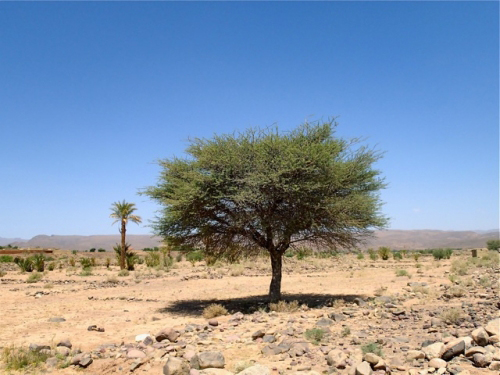
ALVIN JOHNSON takes a look at the the role of the shittah, identified as the acacia, and its role in the Bible…
Timber from the shittah was used to make the Tabernacle and the Ark of the Covenant. The shittah is identified as the acacia and there are many species of acacia that can be found in Israel.

The shittah (acacia) was important for its shade and it’s believed the Acacia raddiana (pictured) was used in the making of the Ark of the Covenant. PICTURE: Floratrek/CC BY-SA 3.0
These include:
• the umbrella thorn acacia – Acacia tortilos;
• the spiral acacia (also called the common acacia) – Acacia raddiana;
• the Negev acacia – Acacia gerradii;
• the red acacia – Acacia seyal;
• the Acacia pachyceras;
• the prickly acacia – Acacia nilotica; and,
• the white acacia – Acacia albida (although it is no longer part of the Acacia genus)
We will focus on a few of the above examples.
The umbrella thorn acacia (Acacia tortilus) is an extremely thorny tree. It is a small evergreen tree which can grow to between four to seven metres. It has a central trunk that branches out from its base which forms an awning shape. Its fruit is eaten by many of the desert animals. It is commonly found in the Aravah valley, the southern Dead Sea region and in the Negev. However, importantly for our discussion, it was not found in the Sinai.
It is the spiral acacia (Acacia raddiana) that is the most common tree in Israel’s deserts. It survives in these hot and dry conditions because it has long roots to reach underground water. Because it is the only large tree in the desert it is used for shade. For this reason the Bedouins protect the tree and do not use it for burning. It obtains its name from the spiral shape of the fruit pod.
Because it is the most significant tree in the desert, it is believed that this was the acacia that was used in the construction of the tabernacle.
Exodus chapters 25 to 38 records how acacia wood was used to make the items used in the tabernacle such as the Ark of the Covenant, the table of showbread, the altar of incense and the frame for the outer courtyard tent.
Moses says in Deuteronomy 10:3: “So I made an ark of shittah (acacia) wood, and cut two tables of stone like the first, and went up onto the mountain, having the two tables in my hand.”
Nogah Hareuveni, the founder and past director of Neot Kedumim Biblical Landscape Reserve Israel*, comments in Tree and Shrub in Our Biblical Heritage about the size of the acacia required: “Although most acacia trees known today in the Sinai do not develop tall trunks, it is possible to see individual acacia trees whose trunk is straight and tall enough even for use as the central bar of the Tabernacle which was about 15 metres long.”
The shittah is mentioned in the promise given by God through the prophet Isaiah: “I will turn the desert into pools of water, and the parched ground into springs. I will put in the desert the cedar (erez) and the shittah (acacia), the myrtle (hadas) and the olive (shemen lit. oil). I will set pines (berosh) in the wasteland, the fir (tidhar) and the cypress (te’ashur) together, so that people may see and know, may consider and understand, that the hand of the Lird has done this, that the Holy One of Israel has created it.” (Isaiah 41:18-20)
In this passage the acacia is not a desert tree, but one that can be found in moist and fertile areas. This might be the white acacia (Acacia albida). This is found in such areas of Israel, for example on the Sharon plain and in Lower Galilee.
The Old Testament also mentions a valley named after the shittah: “And it will come about in that day that the mountains will be dropping sweet wine, and the hills will be flowing with milk, and all the streams of Judah will be flowing with water; and a fountain will come out from the house of the Lord, watering the valley of shittah (acacia) trees” (Joel 3:18)
From the description this valley was to be located somewhat near the temple (“the house of the Lord”). This may be the Kidron Valley, this valley runs east of the Temple and on down to the Dead Sea. In this imagery the valley of acacias may again refer to the acacias that are found in arid conditions. This prophetic promise of Joel may parallel a similar promise found in Ezekiel where water flows from the temple down to the Dead Sea. This water brings vegetation and life to this dry region of the country (see Ezekiel 47: 1-12, cf. Zechariah 14:8).
* For those interested in flora of the Bible and who also are planning to visit Israel, I would highly recommend a visit to the Neot Kedumim, a 550 acre reserve set midway between Tel Aviv and Jerusalem.




